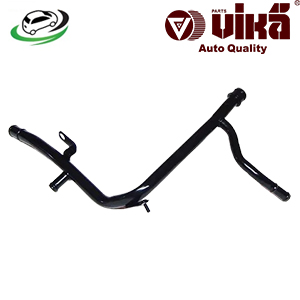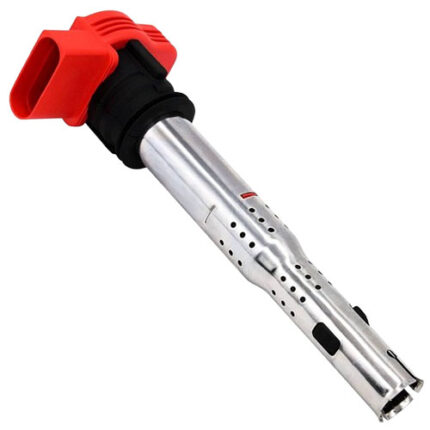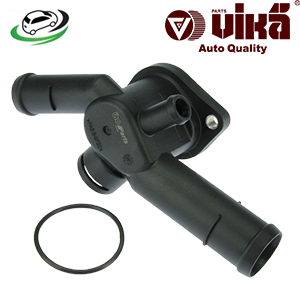Get Cooling Hose Flange Volkswagen Golf IV 2.0 / VW Jetta IV 1.8T / VW Jetta IV 2.0 06A121132
A cooling hose flange is a crucial component in an engine’s cooling system, serving as the connection point between the engine block, various hoses, and other cooling system parts like the radiator, heater core, or thermostat housing. It ensures the secure and efficient flow of coolant through the system, helping to regulate engine temperature and prevent overheating. In this comprehensive exploration, we’ll delve into the design, function, types, common issues, and maintenance of the cooling hose flange.
Design and Function
Design:
- Materials:
- Metal Flanges: Traditionally, cooling hose flanges were made from metals like aluminum, steel, or cast iron due to their strength, durability, and resistance to high temperatures. Metal flanges are particularly useful in areas of the cooling system exposed to significant heat and pressure.
- Plastic Flanges: In modern vehicles, plastic flanges made from high-strength polymers like reinforced nylon or polypropylene have become common. These materials are lighter and often more cost-effective than metal, though they must be designed to withstand high temperatures and pressure without degrading.
- Seals and Gaskets: The flange typically incorporates seals or gaskets made from rubber or silicone to ensure a tight, leak-proof connection between the flange and the engine block, hoses, or other components.
- Structure:
- Shape and Configuration: The shape and configuration of a cooling hose flange vary depending on its location and function within the cooling system. Most flanges are designed with a flat surface that bolts to the engine block or other component, with one or more protruding hose connections.
- Hose Connections: The flange includes one or more spouts or outlets where hoses attach. These connections are often barbed or ribbed to secure the hose and prevent it from slipping off under pressure.
- Bolt Holes: The flange has bolt holes or mounting points that allow it to be securely fastened to the engine block or another component, ensuring a stable and leak-proof connection.
Functionality:
- Connecting Cooling System Components:
- Coolant Distribution: The primary function of the cooling hose flange is to connect various components of the cooling system, such as the engine block, radiator, heater core, and thermostat housing. It acts as a junction point, allowing coolant to flow between these parts.
- Maintaining Seals: The flange ensures a tight seal between the engine block and the attached hoses or components, preventing coolant leaks and maintaining the integrity of the cooling system.
- Directing Coolant Flow:
- Controlled Flow: The flange plays a role in directing the flow of coolant through the system. Depending on its design and location, it can direct coolant to specific areas of the engine or to other parts of the cooling system, ensuring that all areas receive adequate cooling.
- Supporting Thermostat Function: In cases where the flange is part of the thermostat housing, it also helps regulate the flow of coolant based on engine temperature, ensuring that the engine reaches and maintains its optimal operating temperature.
Importance of the Cooling Hose Flange
- Engine Protection:
- Preventing Overheating: By ensuring the proper flow of coolant through the engine, the cooling hose flange plays a vital role in preventing engine overheating. Overheating can lead to severe engine damage, including warping of the cylinder head, gasket failure, and even complete engine failure.
- Maintaining Efficiency: A well-functioning cooling hose flange contributes to the overall efficiency of the engine. By maintaining a stable engine temperature, it helps the engine operate more efficiently, improving fuel economy and reducing emissions.
- System Integrity:
- Preventing Leaks: The cooling hose flange is essential for maintaining the closed-loop nature of the cooling system. A secure, leak-free connection at the flange ensures that coolant remains within the system, preventing leaks that could lead to overheating and potential engine damage.
- Supporting Component Functionality: The flange supports the functionality of other cooling system components by ensuring they are properly connected and receiving the correct flow of coolant. This is critical for components like the radiator, heater core, and thermostat to function correctly.
- Versatility:
- Multiple Applications: Cooling hose flanges are used in various parts of the engine’s cooling system, making them versatile components. They can be found at connections between the engine block and radiator, heater core, water pump, and thermostat housing.
- Adaptability: The design of cooling hose flanges can be adapted to different engine configurations and cooling system layouts, making them suitable for a wide range of vehicles and applications.
Types of Cooling Hose Flanges
- Single-Port Flanges:
- Simple Design: Single-port flanges are designed with one outlet for connecting a single hose. These flanges are often used in straightforward applications where a single connection is needed between two components, such as the engine block and a radiator hose.
- Common Uses: Single-port flanges are commonly found in smaller or less complex cooling systems, or in locations where only one hose needs to be connected.
- Multi-Port Flanges:
- Complex Design: Multi-port flanges feature multiple outlets for connecting multiple hoses. These flanges are used in more complex cooling systems where multiple connections are required, such as between the engine block, heater core, and radiator.
- Versatility: Multi-port flanges are versatile and can be designed to accommodate various hose sizes and configurations, making them suitable for more intricate cooling system layouts.
- Thermostat Housing Flanges:
- Integrated Thermostat: Some cooling hose flanges are integrated with the thermostat housing, combining the functions of directing coolant flow and housing the thermostat. This design simplifies the cooling system and reduces the number of separate components needed.
- Temperature Regulation: The thermostat housing flange plays a critical role in regulating the engine temperature by controlling the flow of coolant based on the thermostat’s position.
Common Issues with Cooling Hose Flanges
- Leaks:
- Cracks and Breakage: Over time, cooling hose flanges, especially those made of plastic, can develop cracks or break due to exposure to high temperatures, pressure fluctuations, and vibrations. Metal flanges, while more durable, can also crack under stress or due to corrosion.
- Seal Degradation: The seals or gaskets used with the flange can degrade over time, leading to coolant leaks. This is particularly common in older vehicles or those with high mileage.
- Loose Connections: Bolts or clamps securing the flange can loosen over time, particularly if not properly torqued during installation. Loose connections can result in coolant leaks and reduced system pressure.
- Corrosion:
- Metal Flanges: Metal flanges, especially those made from less corrosion-resistant materials, can corrode over time. Corrosion weakens the flange, making it more susceptible to leaks and failure.
- Coolant Contamination: Contaminated coolant can accelerate corrosion in metal flanges. This is why regular coolant changes and using the correct type of coolant are important to prevent corrosion-related issues.
- Warping:
- Heat Damage: Prolonged exposure to high temperatures can cause some plastic flanges to warp. Warped flanges may not seal properly, leading to coolant leaks and potential overheating issues.
- Improper Installation: Incorrect installation, such as over-tightening bolts, can cause the flange to warp, especially if it’s made of plastic. This can result in an uneven seal and leaks.
- Clogging:
- Sediment Build-up: Sediment or debris in the cooling system can accumulate in the flange, especially if it has narrow passages or multiple ports. This can restrict coolant flow, leading to overheating and reduced cooling efficiency.
- Coolant Gelation: Using incompatible coolants or mixing different types of coolant can lead to gelation, where the coolant thickens and clogs the system, including the cooling hose flange.
Maintenance and Inspection
- Regular Inspection:
- Visual Checks: Regularly inspect the cooling hose flanges for signs of wear, damage, or leaks. Look for coolant residue around the flange, which may indicate a leak, and check for cracks or warping, particularly in plastic flanges.
- Check Coolant Levels: A sudden drop in coolant levels can indicate a leak at the flange or elsewhere in the cooling system. Regularly check the coolant level in the radiator and overflow tank.
- Coolant Maintenance:
- Regular Coolant Changes: Change the coolant at intervals recommended by the vehicle manufacturer. Fresh coolant helps prevent corrosion, sediment build-up, and other issues that can affect the flange.
- Use the Correct Coolant: Always use the coolant specified by the vehicle manufacturer to avoid issues like corrosion, gelation, and other coolant-related problems that can affect the cooling hose flange.
- Replacement Intervals:
- Follow Manufacturer’s Recommendations: Replace cooling hose flanges according to the manufacturer’s recommended intervals, or sooner if any signs of wear, damage, or leaks are detected.
- Proactive Replacement: If you notice any signs of aging or wear during an inspection, replace the flange proactively to avoid sudden failures that could lead to engine overheating.
- Proper Installation:
- Torque Specifications: Follow the manufacturer’s torque specifications when tightening bolts or clamps to avoid over-tightening, which can warp or crack the flange.
- Ensure Proper Sealing: When installing a new flange, ensure that all seals and gaskets are properly seated and in good condition. This will help prevent leaks and ensure a tight, secure connection.
Follow us on Facebook for more parts.



